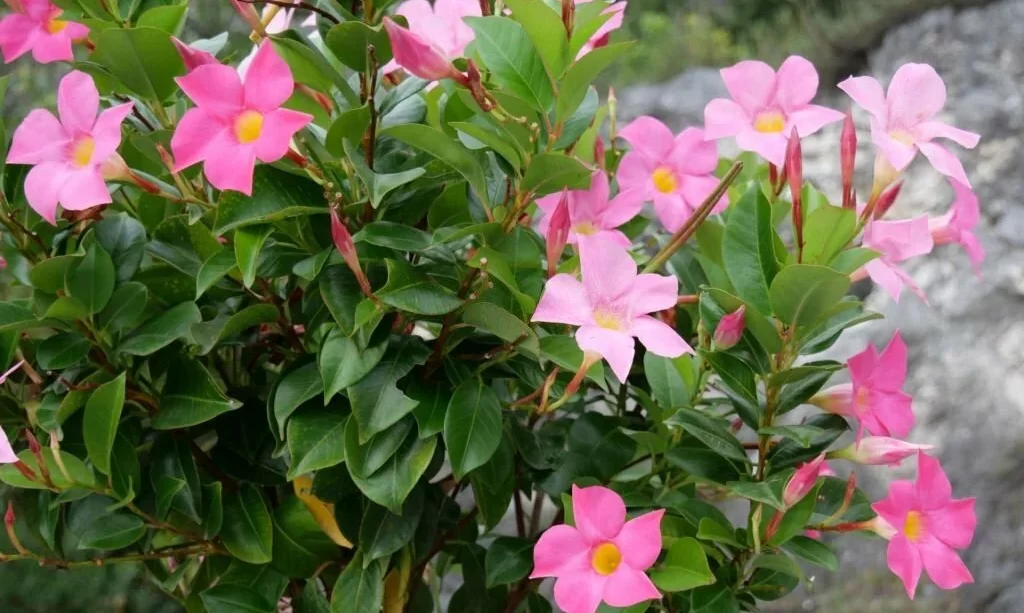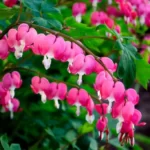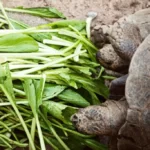In the world of ornamental vines, the Mandevilla stands as a radiant symbol of tropical beauty and elegance. Its dazzling, trumpet-shaped flowers and lush green foliage make it a favorite among gardeners and enthusiasts alike. The desire to propagate and grow more of these enchanting plants is a natural inclination, given their irresistible charm. This article embarks on a journey into the art of propagating Mandevilla, uncovering the methods that allow you to nurture new vines, prolong their graceful presence, and bring a touch of the tropics to your garden or living space.
- Dipladenia Mandevilla Plant Pot: The lovely Dipladenia Mandevilla is a stunning bushy plant. Featuring bold, trumpet-like blooms and glossy, dark green leaves, the Dipladenia Mandevilla plant is an exotic-looking bush
- Indoor Plants: Dipladenia plants bloom with showy, fragrant, five-petaled red flowers. Attractive to hummingbirds and bees, the colorful plants are ideal for inviting wildlife into your living space. The USDA hardiness zone for outdoor planting is 9–11
- Easy Maintenance: Dipladenia Mandevilla plants are easy to care for; they prefer full sun to partial shade, with the ideal temperature being 68–75 °F. A heat pack is included with each plant if your region experiences cold weather
- Home and Garden Decor: An ideal outdoor and indoor plant, our Dipladenia plant pot is perfect for windowsills, countertops, desks, and tables in your home or garden. The plant can grow up to 1-2′ tall and is a great gift option for friends and family
- Health Benefits: Live plants purify the air in their surroundings and thus enable you to inhale clean, fresh air while also helping to boost mood levels. The plant is mildly toxic to humans and pets if ingested
Mandevilla Plants
Before diving into the propagation techniques, it’s essential to familiarize ourselves with the nature and requirements of Mandevilla plants. Mandevilla, also known as Dipladenia, belongs to the Apocynaceae family and comprises several species, each characterized by vibrant, trumpet-shaped flowers and glossy, dark-green leaves.
Understanding the basics of Mandevilla care is crucial, as it forms the foundation for successful propagation. These tropical vines hail from South America and thrive in warm, sunny conditions with well-drained soil. They are best known for their prolific flowering, which comes in various colors, including shades of red, pink, and white, and their ability to transform any setting into a tropical paradise.
As we embark on the journey of propagating Mandevilla, knowing these plants inside and out will ensure that the new vines receive the care and attention they need to thrive and grace your garden with their stunning blooms.
Propagation by Stem Cuttings
Propagating Mandevilla plants through stem cuttings is one of the most popular and reliable methods. Here’s how to do it:
Taking the Cuttings:
- Choose a healthy parent plant with strong, disease-free growth.
- Select a mature, non-flowering stem, usually in the spring or early summer. The chosen stem should have a few leaf nodes, which are the small bumps where leaves emerge.
- Use a clean, sharp knife or pruning shears to cut a section of the stem that is around 4-6 inches in length. Make the cut just below a leaf node.
Rooting the Cuttings:
- Remove the leaves from the lower part of the cutting, leaving at least one or two nodes with leaves at the top.
- Dip the cut end of the stem into a rooting hormone to encourage root development. Shake off any excess powder.
- Plant the cutting in a well-draining potting mix, ensuring that the node where leaves were removed is buried in the soil. This is where new roots will form.
- Place the potted cutting in a warm, bright location with indirect sunlight. Keep the soil consistently moist but not waterlogged.
Roots typically develop in several weeks, and once the new plant is well-rooted, it can be transplanted into a larger container or into the garden, where it will grow into a mature Mandevilla vine and eventually produce its signature trumpet-shaped flowers.
Propagation by Layering
Propagation by layering is an alternative method for multiplying Mandevilla plants and is particularly suited for outdoor Mandevilla vines. Here’s how to propagate by layering:
Layering Process:
- Identify a long, flexible stem on the parent Mandevilla plant, preferably one that’s not flowering. This is the stem you’ll use for layering.
- Make a small incision on the underside of the stem, just below a node (a small bump where leaves or branches grow). This incision should be about 1-2 inches long.
- Carefully bend the incised portion of the stem down to the ground and bury it in a shallow trench, leaving the exposed tip of the stem above the soil.
- Use a small stone or piece of wire to keep the buried portion of the stem in contact with the soil.
- Water the soil around the layered stem to ensure it remains consistently moist.
- After a few weeks to a few months, roots will develop from the buried portion of the stem. You can check for root development by gently tugging on the stem. If it resists being pulled up, roots have formed.
Once the layered stem has developed strong roots, you can carefully cut it from the parent plant and transplant it to a new location, whether in your garden or a container. This method is an effective way to expand your Mandevilla collection while maintaining the characteristics of the parent plant.
- 2 Mandevilla Plants, Yellow Mandevilla Starter Well Rooted, 5 Inc to 7 Inc Tall, Tropical Plant Live
Starting from Seeds
While less common than stem cuttings or layering, propagating Mandevilla from seeds is a rewarding endeavor, particularly for those who enjoy the full cycle of plant growth. Here’s how to propagate Mandevilla from seeds:
Seed Harvesting:
- Wait until the parent plant’s flowers have faded and produced seed pods. These pods are small, elongated, and contain numerous tiny seeds.
- Collect the seed pods when they turn brown and begin to split open, revealing the seeds inside.
Seed Planting:
- Sow the seeds in a seed tray or small pots filled with a well-draining potting mix.
- Gently press the seeds into the soil, but do not bury them too deep. The goal is to maintain good seed-to-soil contact.
- Keep the soil consistently moist but not waterlogged, and place the tray or pots in a warm, well-lit area.
- Germination may take several weeks to a few months, so be patient.
Once the seedlings have developed a few sets of true leaves, they can be transplanted into larger containers or directly into your garden. Be mindful that growing Mandevilla from seeds requires time and nurturing, but the result is the satisfaction of nurturing a plant from its earliest stages.
- Appearance: Mandevilla sanderi is known for its showy, trumpet-shaped flowers that come in a range of colors including shades of pink, red, and white. The flowers often have a subtle fragrance that adds to their charm. The foliage is glossy and dark green, providing an attractive backdrop for the vibrant blooms.
- Growing Habit: This plant is a climbing vine that can reach heights of 6 to 10 feet or more. It uses tendrils to cling onto supports such as trellises, fences, or arbors. In tropical and subtropical regions, it can even be grown as a ground cover.
- Flowering Period: Mandevilla sanderi typically produces flowers from spring to fall, depending on the climate and growing conditions. The blooms appear in clusters and create a visually striking display against the lush green foliage.
- Uses: Mandevilla sanderi is used primarily for ornamental purposes. It adds a tropical and exotic flair to gardens, patios, balconies, and poolside areas. Its climbing habit makes it suitable for vertical gardening and creating living walls. It’s also a popular choice for adding color and visual interest to outdoor spaces in warmer climates.
- Hassle-Free Service: Your satisfaction is our priority. Our after-sales service ensures your confidence in gardening success. In case of no germination or other situations, please contact us in time, and we will solve the problem for you, ensuring your gardening journey is a thriving one.
Care and Maintenance of Propagated Plants
Regardless of the propagation method used, proper care and maintenance of propagated Mandevilla plants are essential to ensure their health and prolific flowering. Here are some key aspects to consider:
- Light: Mandevilla plants thrive in full sunlight, so provide them with at least 6-8 hours of direct sun per day. Be cautious of scorching in extremely hot conditions, and provide some shade if necessary.
- Water: Keep the soil consistently moist during the growing season. Water the plant thoroughly when the top inch of soil feels dry. In the dormant winter months, reduce watering.
- Soil: Plant your Mandevilla in well-draining potting mix or garden soil. Good drainage is essential to prevent root rot.
- Support: As Mandevilla vines grow, they may need support. Use trellises or stakes to encourage upright growth and prevent sprawling.
- Fertilization: Feed your Mandevilla with a balanced, water-soluble fertilizer during the growing season. Follow the recommended dosage on the product label.
- Pruning: Pruning is essential to maintain a healthy and attractive Mandevilla. Remove dead or leggy growth and encourage branching for more blooms.
- LOW MAINTENANCE: Our vine fertilizer is perfect for all homeowners! This slow release fertilizer only requires feeding every 14 days till blooming begins. Once blooming begins, you only need to feed your plants once a month.
- PACKED WITH NUTRIENTS: Our well developed bougainvillea plant food has a 17-7-10 formula promotes the development of healthy colorful blooms, while maintaining the health of your plants. With 4 sources of nitrogen and nutrients for maintaining plant health, this fertilizer allows for extended periods between feedings. This fertilizer works with soil biology to provide your vines with the best fertilizer and nutrition possible, at the right time.
- MAINTAIN YOUR PLANT’S HEALTH: Feel the benefits of a formula that was created to maintain your plants health. With added sulfur and gypsum, our formula helps create acidic soil to improve overall soil structure around the roots.
- FOR BOUGAINVILLEA VINES, BUT NOT LIMITED: This fertilizer was created for bougainvillea vines, but can also be applied to allamanda, coral vines, dipladenia, honeysuckles, jessamines, mandevilla, passion vines, queen anne’s lace, trumpet vines, and wisteria vines. This fertilizer comes in 4 sizes; 2lb, 4lb, 15lb, 25lb.
- EASY APPLICATION: Ditch the liquid fertilizer and enjoy all the benefits of a granular fertilizer. Our slow release granules help feed your plants for longer. Perfect for indoor and outdoor use, easily feed hanging, potted and grounded vines.
Conclusion
Propagating Mandevilla plants is a delightful journey that not only multiplies your garden’s beauty but also deepens your connection with these vibrant vines. Each propagation method, whether by stem cuttings, layering, or seeds, comes with its unique charm and challenges. Successfully propagating Mandevilla not only rewards you with new specimens to enjoy but also allows you to share the joy of these enchanting flowering vines with others.
As you explore these diverse propagation methods, remember that patience, care, and attention are your greatest allies. Understanding the specific requirements of your chosen method and providing proper care are key to nurturing healthy, thriving Mandevilla plants.
In conclusion, propagating Mandevilla is an art and a science, a labor of love that enriches your garden and your connection with the natural world. Each propagated plant represents a piece of your horticultural journey, a testament to the enduring beauty and wonder of these extraordinary botanical treasures.







